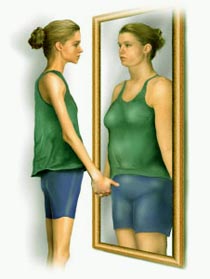Anorexia and bulimia are abnormalities of nutritional behaviour that are typical mainly of women. According to western psychiatrists about 4% of young women aged 14 to 20 suffer from these eating disorders. And it is quite natural as at teenage age young girls pay a special attention to their appearance and are very sensitive to others opinion about their looks. The standards of beauty also play a great role. The image of a fragile, air and graceful woman has become a standard of beauty in the second half XX and the beginning of the XXI century. There is nothing bad when a young girl watches her body weight and keeps fit but only if it goes within the reasonable norm. But quite often young ladies take it to extremes. Sometimes only a slight stoutness or wide cheekbones bring great dissatisfaction and distorted image of one's looks. They begin to regard their own appearance as defective. As a result their are depressed about it, their mood is often low and they have a feeling that people pay heed to their "ugliness" and laugh about them. It all leads to the dysmorphophobic syndrome when young girls start feeling keenly about their (often thought-out) "physical defects". They come to the conclusion about necessity of growing thin and begin to strive against their "extra-kilos" in different ways and to different extent. And it is very often that this struggle turns to psychologically conditioned diseases known as anorexia and bulimia. Sad but true:(
Recent studies showed that it is not only teenage ladies that pay such an excessive attention to their look what leads to abnormalities of nutritional behaviour. Even quite elderly women can be very worried about their appearance. Statistics say that about 60% of women aged 60 to 70 are dissatisfied with their body weight and "extra-kilos". 4% of them have the diagnosis of anorexia and bulimia. So women of any age can fall victim of the disease.
Recent studies showed that it is not only teenage ladies that pay such an excessive attention to their look what leads to abnormalities of nutritional behaviour. Even quite elderly women can be very worried about their appearance. Statistics say that about 60% of women aged 60 to 70 are dissatisfied with their body weight and "extra-kilos". 4% of them have the diagnosis of anorexia and bulimia. So women of any age can fall victim of the disease.
